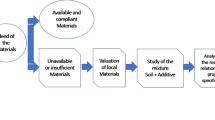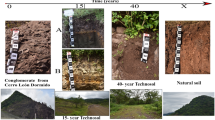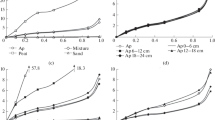Abstract
Purpose
Constructed soils are Technosols resulting from the deliberate combination of various artefacts. Similarly to natural soils, technogenic parent materials are transformed by pedogenic factors contributing to their evolution. This work was conducted to study the first stages of the pedogenesis of constructed soils.
Materials and methods
Two soils were constructed in lysimetric plots (10 × 10 m) using an engineering process by the combination of paper-mill sludge, thermally treated soil material and green waste compost. Evolution of the soil profiles, composition of soils and leachates were studied for 3 years.
Results and discussion
A strong evolution of the profiles was observed over the 3 years with rapid changes in the number and characteristics of the horizons. Significant changes in chemical weathering (decarbonatisation) and physical status (aggregation), i.e. processes similar to those occurring in natural soils were observed. Other processes specific to the technogenic materials were recorded, e.g. massive dissolution of gypsum or drainage of constitutive water. Apart from constructed Technosols classification, prediction was made on their future pedogenic evolution.
Conclusions
Constructed Technosols made of finely divided reactive organic and mineral compounds were observed to evolve quickly. Evidences of original pedogenic processes have been highlighted that could be considered as a general diagnostic characteristic of Technosols. Finally, some considerations about the application of the World Reference Base for Soil Resources to the classification of Technosols are proposed, taking into account some aspects of their pedogenesis that have been highlighted by our work.





Similar content being viewed by others
References
AFNOR (Association Française de Normalisation) (2004) Evaluation de la qualité des sols volume 1: méthodes d’analyse chimique. Association Française de Normalisation, La Plaine Saint-Denis Cedex, p 461
Anderson SP, Dietrich WE, Brimhall GH Jr (2002) Weathering profiles, mass balance analysis, and rates of solute loss: linkages between weathering and erosion in a small, steep catchment. Geol Soc Am Bull 114:1143–1158
Badin AL, Méderel G, Béchet B, Borschneck D, Delolme C (2009) Study of the aggregation of the surface layer of Technosols from stormwater infiltration basins using grain size analyses with laser diffractometry. Geoderma 153:163–171
Baumgartl T (1998) Physical soil properties in specific fields of application especially in anthropogenic soils. Soil Till Res 47(1–2):51–59
Beyer L, Cordsen E, Blume HP, Schleuß U, Vogt B, Wu Q (1996) Soil organic matter composition in urbic anthrosols in the city of Kiel, NW-Germany, as revealed by wet chemistry and CPMAS 13C-NMR spectroscopy of whole soil samples. Soil Technol 9:121–132
Bradshaw AD (1983) The reconstruction of ecosystems. J Appl Ecol 20:1–17
Bruand A, Duval O, Gaillard H, Darthout R, Jamagne M (1996) Variabilité des propriétés de rétention en eau des sols: importance de la densité apparente. Etude et Gestion des Sols 3(1):27–40
Chadwick OA, Chorover J (2001) The chemistry of pedogenic thresholds. Geoderma 100:321–353
Cousin I, Nicoullaud B, Coutadeur C (2003) Influence of rock fragments on the water retention and water percolation in a calcareous soil. CATENA 53(2):97–114
Duchaufour P (1983) Pédologie 1. Pédogénèse et classification, 2nd edn. Masson, Paris, p 491
El Khalil H, Schwartz C, Elhammiani O, Kubiniok J, Morel JL, Boularbah A (2008) Contribution of technic materials to the mobile fraction of metals in urban soils in Marrakech (Morocco). J Soils Sediments 8(1):17–22
Farouki OT (1986) Thermal properties of soils, vol 11. Trans. Tech. Publications, Clausthal-Zellerfeld, p 136
Hiller DA (2000) Properties of Urbic Anthrosols from an abandoned shunting yard in the Ruhr area, Germany. CATENA 39(4):245–266
IUSS Working Group WRB (2006) World reference base for soil resources 2006. A framework for international classification, correlation and communication, 2nd edn. World Soil Resources Reports, 132, pp 145
Jenny H (1941) Factors of soil formation: a system of quantitative pedology. McGraw Hill Book Company, New York, p 281
Lefort C, Schwartz C, Florentin L, Gury M, Morel JL (2006) Determination of model substrates for the study of the pedogenesis of Technosols. Workshop on modelling of pedogenesis, pp 75–76
Lehmann A (2006) Technosol and other proposals on urban soils for the WRB (World Reference Base for Soil Resources). Int Agrophys 20:129–134
Lehmann A, Stahr K (2007) Nature and significance of anthropogenic urban soils. J Soils Sediments 7:247–260
Lemaire F, Rossignol JP (1999) Stress factors related to urban soils. Acta horticulturae 496:347–351
Lorenz K, Kandeler E (2005) Biochemical characterization of urban soil profiles from Stuttgart, Germany. Soil Biol Biochem 37(7):1373–1385
Monserié MF, Watteau F, Villemin G, Ouvrard S, Morel JL (2009) Technosol genesis: identification of organo-mineral associations in a young Technosol derived from coking plant waste materials. J Soils Sediments 9:537–546
Morel JL, Habib L, Plantureux S, Guckert A (1991) Influence of maize root mucilage on soil aggregate stability. Plant Soil 136:111–119
Morel JL, Schwartz C, Florentin L, de Kimpe C (2005) Urban soils. In: D Hillel (ed) Encyclopedia of soils in the environment, vol 1–4. Elsevier, Oxford, pp 202–208
Nehls T, Hartstock S, Stoffregen H, Wessolek G (2007) Stability of preferential flow paths in paved urban soils. Geophys Research, Abstracts 9
Payet C (2001) Les végétaux comme facteur d’évolution des boues urbaines en stockage prolongé, Mémoire de Thèse de doctorat en Sciences Agronomiques, INPL, pp 145
Pedro G (1964) Contribution à l'étude expérimentale de l'altération géochimique des roches cristallines. Centre National de Recherches Agronomiques, pp 345
Rossiter DG (2007) Classification of urban and industrial soils in the World Reference Base for Soil Ressources. J Soils Sediments 7:96–100
Scalenghe R, Ferraris S (2009) The first forty years of a Technosol. Pedosphere 19(1):40–52
Schleuß U, Wu Q, Blume HP (1998) Variability of soils in urban and periurban areas in Northern Germany. CATENA 33(3–4):255–270
Scholtus N, Leclerc-Cessac E, De Donato P, Morel JL, Simonnot MO (2009) Eluto-frontal chromatography to simulate chemical weathering of COx by low-molecular-weight organic compounds and early pedogenesis processes. Eur J Soil Sci 60(1):71–83
Schwartz C, Florentin L, Morel JL (2003) Impact d’activités militaires de la première Guerre Mondiale sur la qualité des sols. INPL(ENSAIA)/INRA, pp 28
Séré G (2007) Fonctionnement et évolution pédogénétique de Technosols issus d’un procédé de construction de sol. Mémoire de Thèse de doctorat en Sciences Agronomiques, INPL, pp 227
Séré G, Schwartz C, Ouvrard S, Sauvage C, Renat JC, Morel JL (2008) Soil construction: a step for ecological reclamation of derelict lands. J Soils Sediments 8(2):130–136
Simonson RW (1959) Outline of a generalized theory of soil genesis. Soil Sci Soc Am Proc 23:152–156
Sommer M (2006) Influence of soil pattern on matter transport in and from terrestrial biogeosystems—a new concept for landscape pedology. Geoderma 133:107–123
Villemin G, Watteau F, Morel JL (2007) La visualisation et la micro-analyse des composts en microscopie électronique: une clef pour la qualité, la fabrication et l’utilisation des composts. Techniques, Sciences et Méthodes 5:67–78
Zanuzzi A, Arocena JM, van Mourik JM, Faz Cano A (2009) Amendments with organic and industrial wastes stimulate soil formation in mine tailings as revealed by micromorphology. Geoderma 154:69–75
Acknowledgements
This project is supported by the GISFI programme (www.gisfi.fr); it was financed by the Etat Français (ANRT), Région Lorraine (CPER), ADEME and received technical support from Etablissement Public Foncier de Lorraine and Arcelor-Mittal Real Estate France. The authors wish to thank Stéphane Colin, Alain Rakoto and Jean-Claude Bégin for their precious technical help.
Author information
Authors and Affiliations
Corresponding author
Additional information
Responsible editor: Andreas Lehmann
Rights and permissions
About this article
Cite this article
Séré, G., Schwartz, C., Ouvrard, S. et al. Early pedogenic evolution of constructed Technosols. J Soils Sediments 10, 1246–1254 (2010). https://doi.org/10.1007/s11368-010-0206-6
Received:
Accepted:
Published:
Issue Date:
DOI: https://doi.org/10.1007/s11368-010-0206-6




